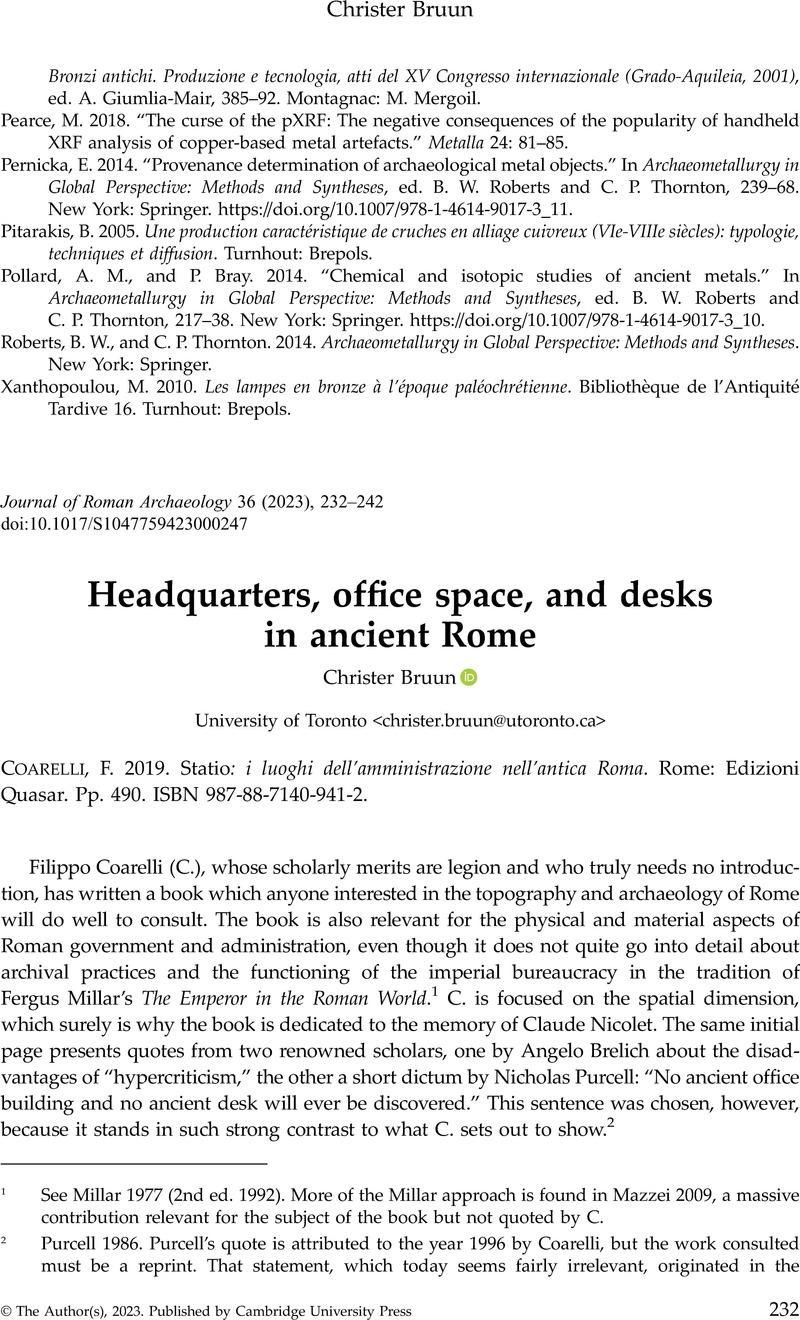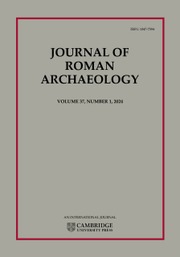No CrossRef data available.
Article contents
Headquarters, office space, and desks in ancient Rome - F. Coarelli 2019. Statio: i luoghi dell'amministrazione nell'antica Roma. Rome: Edizioni Quasar. Pp. 490. ISBN 987-88-7140-941-2.
Review products
F. Coarelli 2019. Statio: i luoghi dell'amministrazione nell'antica Roma. Rome: Edizioni Quasar. Pp. 490. ISBN 987-88-7140-941-2.
Published online by Cambridge University Press: 28 June 2023
Abstract
An abstract is not available for this content so a preview has been provided. Please use the Get access link above for information on how to access this content.

- Type
- Book Review
- Information
- Copyright
- Copyright © The Author(s), 2023. Published by Cambridge University Press
References
Bruun, C. 1989. “Statio aquarum.” In Lacus Iuturnae I, ed. Steinby, E. M., 127–47. Lavori e studi di archeologia 12. Rome: De Luca edizioni d'arte.Google Scholar
Bruun, C. 2007. “Aqueductium e statio aquarum. La sede della cura aquarum di Roma.” In ‘Res bene gestae’: ricerche di storia urbana su Roma antica in onore di Eva Margareta Steinby, ed. Leone, A., Palombi, D., and Walker, S., 1–14. Rome: Edizioni Quasar.Google Scholar
Burgers, P. 1999. “Statio aquarum.” In Lexicon Topographicum Urbis Romae IV, ed. Steinby, E. M., 346–49. Rome: Edizioni Quasar.Google Scholar
Carandini, A., and Carafa, P., eds. 2012. Atlante di Roma antica: biografia e ritratti della città, 2 vols. Milan: Mondadori Electa.Google Scholar
Carandini, A., and Carafa, P., eds. 2017. The Atlas of Ancient Rome. Biography and Portraits of the City, 2 vols. Princeton, NJ, and Oxford: Princeton University Press.Google Scholar
Coarelli, F. 1993a. “Atrium Libertatis.” In Lexicon Topographicum Urbis Romae I, ed. Steinby, E. M., 133–35. Rome: Edizioni Quasar.Google Scholar
Coarelli, F. 1993b. “Catabulum.” In Lexicon Topographicum Urbis Romae I, ed. Steinby, E. M., 256. Rome: Edizioni Quasar.Google Scholar
Coarelli, F. 1997. Il Campo Marzio: dalle origini alla fine della Repubblica. Rome: Edizioni Quasar.Google Scholar
Coarelli, F. 1999. “Statio annonae.” In Lexicon Topographicum Urbis Romae IV, ed. Steinby, E. M., 345–46. Rome: Edizioni Quasar.Google Scholar
Cornell, T. J. 1995. The Beginnings of Rome. Italy and Rome from the Bronze Age to the Punic Wars (c. 1000–264 BC). London and New York: Routledge.Google Scholar
Davies, P. E. J. 2017. Architecture and Politics in Republican Rome. Cambridge: Cambridge University Press.CrossRefGoogle Scholar
Eck, W. 1999. “Statio patrimoni.” In Lexicon Topographicum Urbis Romae IV, ed. Steinby, E. M., 352–53. Rome: Edizioni Quasar.Google Scholar
Faoro, D. 2021. “De statione Augusta Mediolani: su una tessera bronzea d'epoca Giulio-Claudia menzionante un libertus Aug. a rationibus.” ZPE 217: 253–60.Google Scholar
France, J., and Nelis-Clément, J., eds. 2014. La statio. Archéologie d'un lieu de pouvoir dans l'Empire Romain. Scripta Antiqua 66. Bordeaux: Ausonius.Google Scholar
Gorski, G. J., and Packer, J. E.. 2015. The Roman Forum: A Reconstruction and Architectural Guide. Cambridge: Cambridge University Press.CrossRefGoogle Scholar
Lawlor, P. 1992. “An inscription of Trajan in the XIIth century basilica.” In San Clemente. Gli edifici romani, la basilica paleocristiana e le fasi altomedievali, ed. Guidobaldi, F., 327–32. San Clemente Miscellany 4.1. Rome: Collegio San Clemente.Google Scholar
Maiuro, M. 2010. “What was the Forum Iulium used for? The Fiscus and its jurisdiction in first-century CE Rome.” In Spaces of Justice in the Roman World, ed. De Angelis, F., 189–221. Leiden and Boston: Brill.Google Scholar
Manacorda, D. 1999. “Volcanus, aedes.” In Lexicon Topographicum Urbis Romae V, ed. Steinby, E. M., 211–13. Rome: Edizioni Quasar.Google Scholar
Mazzei, P. 2009. “Tabularium – Aerarium nelle fonti letterarie ed epigrafiche.” Rendiconti Accademia dei Lincei ser. 9. 20: 275–378.Google Scholar
Millar, F. G. B. 1977. The Emperor in the Roman World (31 BC – AD 337). London: Duckworth. (2nd ed. 1992.)Google Scholar
Momigliano, A. 1936. “Due punti di storia romana arcaica.” SDHI 2: 373–98 (Repr. in Quarto contributo alla storia degli studi classici e del mondo antico, Rome: Edizioni di Storia e Letteratura 1969, 329–61).Google Scholar
Purcell, N. 1986. “The arts of government.” In The Oxford History of the Classical World, ed. Boardman, J., 560–91. Oxford: Oxford University Press.Google Scholar
Steinby, E. M., ed. 1993–2000. Lexicon Topographicum Urbis Romae I-VI. Rome: Edizioni Quasar.Google Scholar
Tucci, P. L. 2005. “‘Where high Moneta leads her steps sublime,’ The ‘Tabularium’ and the Temple of Juno Moneta.” JRA 18: 6–33.Google Scholar
Tucci, P. L. 2013/2014. “A new look at the Tabularium and the Capitoline Hill.” RendPontAcc 86: 43–123.Google Scholar
Van Haeperen, F. 2019. Regio I: Ostie, Porto. Fana, templa, delubra. Corpus dei luoghi di culto dell'Italia antica 6. Rome: Edizioni Quasar.Google Scholar
Welin, E. 1953. Studien zur Topographie des Forum Romanum. AIRRS 8o, 6. Lund: Gleerup.Google Scholar
Zevi, F. 2007. “Minucia frumentaria, crypta Balbi, circus Flaminius; note in margine.” In ‘Res bene gestae’: ricerche di storia urbana su Roma antica in onore di Eva Margareta Steinby, ed. Leone, A., Palombi, D., and Walker, S., 451–61. Rome: Edizioni Quasar.Google Scholar


